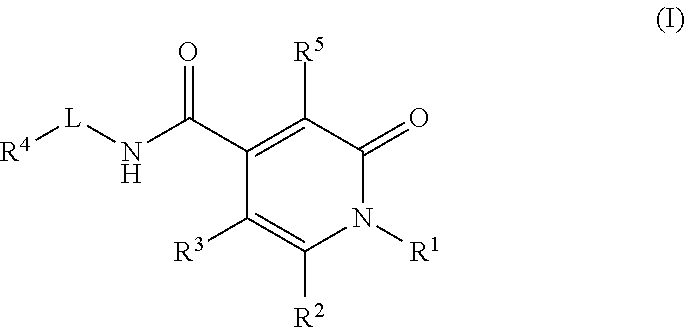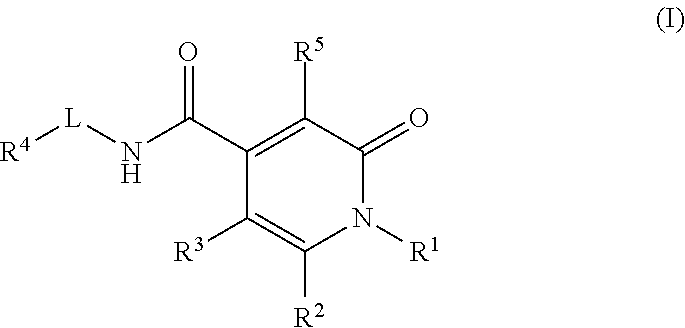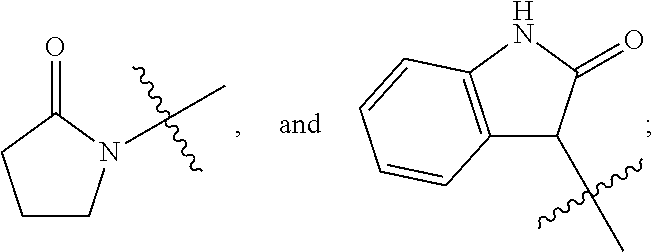Pyridinedione carboxamide inhibitors of endothelial lipase
a technology of endothelial lipase and pyridinedione carboxamide, which is applied in the field of pyridinedione carboxamide compounds and analogues, can solve the problems of a major health risk of cardiovascular diseas
- Summary
- Abstract
- Description
- Claims
- Application Information
AI Technical Summary
Benefits of technology
Problems solved by technology
Method used
Image
Examples
example 1a
6-bromo-N-(3-(3,4-dichlorophenyl)propyl)-3-hydroxy-1-methyl-2-oxo-1,2-dihydropyridine-4-carboxamide
[0405]
[0406]To solution of Intermediate 1 (24.87 mg, 0.1030 mmol) in DCM (1 mL) was added TEA (0.043 mL, 0.31 mmol) followed by the addition of a solution of Intermediate 8 in DCM (1 mL). The reaction was stirred at rt overnight. The reaction was diluted with EtOAc, the solution washed with brine, dried over MgSO4, filtered and concentrated to give the crude product. The crude product was dissolved in a small amount of DCM and charged to a 12 g silica gel cartridge which was eluted with a 25 min gradient from 0-100% EtOAc / hexane to give Example 1A (36 mg, 0.080 mmol, 78% yield) as a white solid.
example 1b
N-(3-(3,4-dichlorophenyl)propyl)-3-methoxy-1-methyl-2-oxo-6-(3-(trifluoromethyl)phenyl)-1,2-dihydropyridine-4-carboxamide
[0407]
[0408]To a solution of Example 1A (25 mg, 0.056 mmol) in DME (1.0 mL) (warmed slightly to give a clear solution) was added 3-(trifluoromethyl)phenylboronic acid (21.20 mg, 0.112 mmol), sodium carbonate (0.084 mL, 0.17 mmol), and Tetrakis(triphenylphosphine)palladium (0)-resin bound (0.11 mmol / g) (24 mg, 2.8 μmol) in a microwave vial. The reaction was degassed and heated at 110° C. for 6 h. The reaction was diluted with DCM, filtered and concentrated. The residue was dissolved in a small amount of DCM and charged to a 12 g silica gel cartridge which was eluted with a 25 min gradient from 0-100% EtOAc / hexane to give Example 1B (33 mg, 0.040 mmol, 71% yield) as a yellow solid. HPLC / MS (Method D) RT=2.1 min, [M+1]+513.0.
example 1
[0409]To a solution of Example 1B (11 mg, 0.025 mmol) in DCM (1.0 mL) was added boron tribromide-methyl sulfide complex (0.016 mL, 0.074 mmol) at rt. The reaction was stirred at rt overnight. The reaction was quenched with MeOH and concentrated. The residue was dissolved in MeOH and purified by reverse phase preparative HPLC (Method H) to give Example 1 (7 mg, 0.02 mmol, 70% yield) as a white solid. HPLC / MS (Method D) RT=0.2 min, [M+1]+261.9. 1H NMR (400 MHz, CHLOROFORM-d) δ ppm 7.36-7.44 (3H, m), 7.29-7.36 (3H, m), 7.13-7.17 (1H, m), 6.91 (1H, dd, J=8.28, 2.01 Hz), 6.78 (1H, s), 5.78 (1H, br. s.), 3.64 (3H, s), 3.24 (2H, q, J=6.78 Hz), 2.36-2.43 (2H, m), 1.53-1.70 (2H, m, J=7.50, 7.50, 7.34, 7.03 Hz).
[0410]Examples 2-47 were synthesized from Example 1A and corresponding boronic acids following a similar procedure described for Example 1. The HPLC-MS data (retention time, mass and conditions) of Example 2-47 are listed in Table 2.
TABLE 2RT LC / MSEx. #StructureName(min)[M + 1]+Methods...
PUM
| Property | Measurement | Unit |
|---|---|---|
| Rg | aaaaa | aaaaa |
| pH | aaaaa | aaaaa |
| volume | aaaaa | aaaaa |
Abstract
Description
Claims
Application Information
 Login to View More
Login to View More - R&D
- Intellectual Property
- Life Sciences
- Materials
- Tech Scout
- Unparalleled Data Quality
- Higher Quality Content
- 60% Fewer Hallucinations
Browse by: Latest US Patents, China's latest patents, Technical Efficacy Thesaurus, Application Domain, Technology Topic, Popular Technical Reports.
© 2025 PatSnap. All rights reserved.Legal|Privacy policy|Modern Slavery Act Transparency Statement|Sitemap|About US| Contact US: help@patsnap.com



